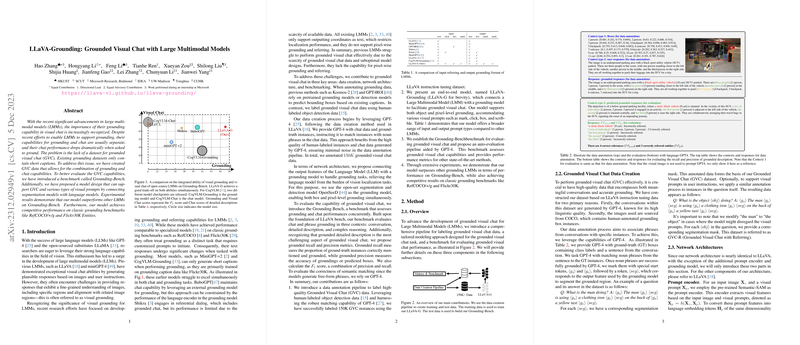Insightful Overview of "LLaVA-Grounding: Grounded Visual Chat with Large Multimodal Models"
The paper "LLaVA-Grounding: Grounded Visual Chat with Large Multimodal Models" presents a significant advancement in the field of large multimodal models (LMMs) by addressing the challenges of grounded visual chat (GVC). The authors have meticulously identified and addressed two primary limitations in existing LMMs: the lack of datasets for grounded visual chat and the distinct separation between grounding and chat capabilities in contemporary models. Traditional models have struggled to effectively integrate these functionalities due to the absence of comprehensive data and suboptimal model designs.
Key Contributions
The paper details several key contributions that aim to revolutionize GVC:
- Creation of GVC Dataset: The authors have developed a high-quality GVC dataset that bridges the gap between visual grounding and conversational capabilities. They have leveraged human-labeled object detection data and enhanced it with GPT-4 to produce quality annotations, resulting in a dataset with 150K grounded visual chat instances.
- Novel Model Architecture: The paper introduces a novel model architecture named LLaVA-Grounding (LLaVA-G). This architecture seamlessly connects a large multimodal model with a grounding model, thereby enabling it to handle both object and pixel-level grounding. The LLaVA-G model can manage various types of visual prompts, such as marks, clicks, boxes, and scribbles.
- Introduction of Grounding-Bench Benchmark: A new benchmark, Grounding-Bench, has been established to evaluate models on their GVC capabilities. The benchmark tests models on their ability to perform in grounded conversations, detailed descriptions, and complex reasoning, providing a robust framework for evaluating GVC models.
- Strong Experimental Results: The experimental results presented in the paper demonstrate that LLaVA-G outperforms existing LMMs on the Grounding-Bench. The model shows competitive performance on classic grounding benchmarks like RefCOCO/+/g and Flickr30K Entities.
Experimental Evaluation
The experimental results are compelling, showcasing LLaVA-G's superior performance over other open-source models on the Grounding-Bench. LLaVA-G achieves a balance between grounding accuracy and chat performance, which has been a challenging feat for previous models. The model's design allows it to outperform on tasks involving both conversation and grounding without compromising on either. The paper emphasizes numerical results, leveraging metrics such as scores to substantiate the performance claims.
Implications and Future Directions
The implications of this research are far-reaching both in theory and practical application. The ability of a model to engage in contextually grounded chat has substantial potential in various real-world applications, such as interactive agents in customer support, educational tools, and enhanced accessibility features. Theoretical implications lie in the improved understanding and integration of multimodal data processing, particularly in the context of artificial intelligence and machine learning.
Future research could explore further expanding the semantic scope of the models to support open-vocabulary settings or fine-tuning the models for specific industry applications. Additionally, exploring the integration of other modalities and expanding the dataset annotation methodologies could provide pathways for future exploration.
In conclusion, "LLaVA-Grounding" effectively addresses the shortcomings of its predecessors and sets a robust framework for future advancements in the field of grounded visual chat. It stands as a testament to the collaborative potential of visual and textual modalities within large-scale models, paving the way for more sophisticated AI systems.
